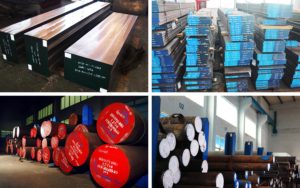How To Manufacture High Quality D2 Tool Steel?
Manufacturing high-quality D2 die steel (a high-carbon, high-chromium cold-working die steel with a composition of approximately C 1.5%, Cr 12%, Mo 0.8%, V 0.9%) requires strict adherence to metallurgical process and heat treatment specifications. The following are the key steps and technical points:
1. Raw Materials & Smelting Control
1. High-purity raw materials
- Use high-quality scrap steel or pure metals (such as iron, chromium, molybdenum, vanadium, etc.) with low sulfur (S < 0.01%) and low phosphorus (P < 0.02%) as raw materials.
- Avoid the mixing of impurity elements (such as lead and tin) to prevent the reduction of steel toughness.
2. Smelting process
- Electric furnace smelting (EAF): After preliminary smelting, transfer to the refining furnace (such as LF furnace) to adjust the composition uniformity.
- Vacuum degassing (VD/VOD): Reduce gas content (hydrogen, oxygen) to prevent internal pores and inclusions.
- Composition control: Accurately adjust the ratio of C, Cr, Mo, and V to ensure compliance with D2 standards (such as ASTM A681).
3. Deoxidation and inclusion control
- Use aluminum (Al) or silicon calcium alloy for deoxidation to reduce oxide inclusions.
- Promote the floating and removal of inclusions through electromagnetic stirring or inert gas stirring.
2. Forging & Hot Working
1. Forging temperature
- Heating temperature: 1100-1150℃ (sufficient homogenization holding time).
- Final forging temperature: ≥900℃, to avoid cracks caused by low temperature forging.
2. Forging process
- Multi-directional forging (upsetting + drawing), breaking coarse carbides in the cast structure.
- Forging ratio ≥3:1, to ensure uniform distribution of carbides.
3. Cooling after forging
- Slow cooling (such as sand cooling or furnace cooling) to prevent stress cracks caused by rapid cooling.
3. Heat Treatment Process
1. Annealing (softening treatment)
- Process parameters: 850-870℃ holding for 2-4 hours, furnace cooling to 500℃ and air cooling.
- Goal: Hardness ≤240 HB, convenient for subsequent machining.
2. Quenching
- Preheating: preheat in two stages (500-550℃ and 800-850℃) to reduce thermal stress.
- Austenitization: keep warm at 1000-1050℃ (time is calculated based on thickness 1-1.5 minutes/mm) to ensure carbide dissolution.
- Cooling medium:
– Oil quenching (suitable for small and medium-sized molds to reduce deformation risk).
– High-pressure gas quenching (vacuum furnace, suitable for high-precision molds to reduce oxidation).
3. Tempering
- First tempering: keep warm at 480-520℃ for 2 hours, air cooling (hardness 58-62 HRC).
- Second tempering: repeat tempering at the same temperature to eliminate residual austenite and improve dimensional stability.
- Third tempering (optional): temper high-precision molds three times to further stabilize the organization.
4. Key Quality Control Points
1. Carbide distribution
– Confirm that the carbide particles are fine and evenly distributed (avoid banded or network carbides) through metallographic inspection (1000x microscope).
2. Balance between hardness and toughness
– When the hardness meets the standard (58-62 HRC), perform impact toughness test (such as Charpy V-notch test).
3. Nondestructive testing
– Ultrasonic testing (UT) or magnetic particle testing (MT) to ensure that there are no defects such as cracks and pores inside.
5. Surface Treatment (optional)
1. Nitriding
– Surface hardness can reach 1000-1200 HV, improving wear resistance and anti-seizure.
2. PVD coating (TiN, CrN)
– Reduce friction coefficient and extend mold life.
6. Typical Problems & Solutions
Problem 1: Mold cracking
- Cause: quenching cooling speed is too fast or tempering is insufficient.
- Solution: Use gas quenching or graded quenching to increase the number of tempering.
Problem 2: Insufficient wear resistance
- Cause: Carbide segregation or quenching temperature is too low.
- Solution: Optimize forging process and increase austenitization temperature.
Through the above process control, D2 mold steel can achieve the comprehensive performance of high hardness, high wear resistance and good dimensional stability, which is suitable for high-end application scenarios such as precision stamping dies and cold shear knives.



